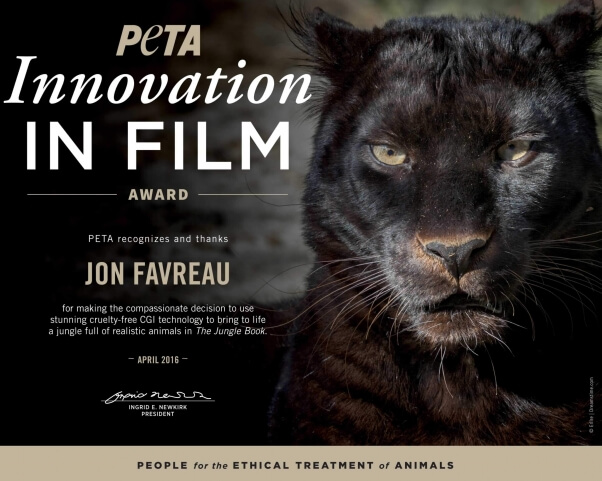See How Jon Favreau and Disney’s ‘The Jungle Book’ Saved Animals
When Jon Favreau set out to direct Disney’s live-action The Jungle Book, which debuts on April 15, he was tasked with bringing to life some of the most iconic animal characters ever seen on screen, from Baloo the bear to Shere Khan the tiger. But rather than relying on abused captive animals to create the film, Favreau turned to advanced computer-generated imagery (CGI), explaining, “It’s amazing what they can do with [creating the appearance of] fur and live-flesh animals, and so every day I go into work it’s astounding what these visual effects artists accomplish.”
The result is a realistic yet mythical world filled with larger-than-life, anthropomorphic animals who live, breathe, fight, and flee amidst lively, lush scenery. And in thanks for Favreau’s compassionate decision, PETA is presenting the director with an Innovation in Film Award.

“Forward-thinking directors like Jon Favreau know that the future of film lies in technical wizardry, not in beating animals into performing,” says PETA Senior Vice President Lisa Lange. “PETA calls on directors and producers throughout Hollywood to follow in Jon Favreau and Disney’s progressive footsteps.”
As technology progresses—and as filmmakers learn how animals suffer from deprivation and abuse in the entertainment industry—the use of digital effects to portray animals is increasing. PETA previously recognized Rupert Wyatt and Darren Aronofsky for the stunning CGI used in Rise of the Planet of the Apes and Noah, respectively.
In addition, PETA’s TV spot “98% Human”—which uses cutting-edge technology to address the plight of great apes used for entertainment—won top honors in visual effects at the prestigious Cannes Lions festival, and the top 10 advertising agencies in the U.S. have signed PETA’s Great Ape Pledge never to use live apes in their projects.
What You Can Do
Avoid seeing movies that use live animals.

